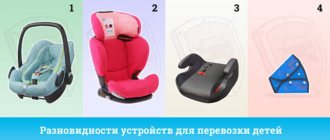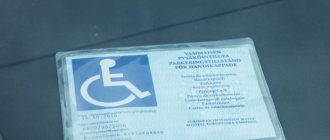According to traffic rules, the driver must wear seat belts when driving and not carry unbelted passengers. Particular attention is paid to the safety of transporting children. Let's look at it in detail:
- What is a "Child Restraint"
- What devices can be used
- Rules for installing restraint devices in cars
- What rules for transporting children were in force before July 2017?
- Rules for transporting children in a car 2020
- Is it possible to use a “booster” when transporting children?
- Fine for a child seat (lack of one)
What is a "Child Restraint"
The concept of a child restraint system is given in GOST R 41.44-2005 ().
According to this standard, a child restraint system is a set of elements consisting of:
- straps or flexible elements with buckles;
- control devices;
- fastening parts;
- and in some cases, an additional device (for example, a bassinet, a removable child seat, a booster seat, and/or an impact shield) that is attached to the interior of the vehicle body.
The device must be designed so that in the event of a collision or sudden braking of the vehicle, it reduces the risk of injury to the child and limits his mobility.
Child restraints are divided into five weight groups:
group 0 (group 0) - for children weighing less than 10 kg; group 0+ (group 0+) - for children weighing less than 13 kg; group I (group I) - for children weighing 9-18 kg; group II (group II) - for children weighing 15-25 kg; group III (group III) - for children weighing 22-36 kg.
The need for child restraints
Safety issues when transporting small passengers are regulated by traffic rules. Article 22.9 gives precise definitions of how a child should be transported:
- Children under 7 years of age can only be transported using special restraints designed for the specific age and height of the small passenger.
- A child aged 7 to 12 years can be transported in the back seat of a car, fastened with a regular seat belt or using a restraint device of the appropriate size (changes from 07/12/2017).
- A child under 12 years of age may travel in the front seat only in a specially equipped child restraint system..
Find out the latest changes in the rules for transporting children in vehicles on the pages of our website.
The presented video clearly demonstrates the need for using restraints in a car and contains basic information about the requirements for transporting children:
So what is a child restraint device (CDU)?
The terminology and specifics are determined by GOST, developed and approved by the Rostekhregulirovaniya decree of December 20, 2005, and which entered into force on January 1, 2007:
- This is a soft or hard design, consisting of flexible belts with a locking mechanism, with adjusters to suit the height and shape of the child;
- other additional devices for safe transportation in a car - a cradle, a special chair, a separately fixed seat, or a screen-type shockproof device;
- All these approved devices for transporting children must be firmly attached to the car body, and in case of sudden braking, secure the passenger in a safe position.
For violation of traffic rules, in accordance with paragraph 3 of Art. 12.23 of the Code of Administrative Offences, the driver is subject to a fine of 3 thousand rubles .
If you need to get legal advice online, you can do this on our page using the feedback form.
What devices can be used
The device can be used if:
- it corresponds to the weight and height of the child;
- its design complies with GOST R 41.44-2005.
Child restraints can be of two types: one-piece and non-one-piece.
One-piece retention devices. They are a set of all the elements necessary to secure the child in the device. Examples: bassinets, car seats.
Non-integral restraint devices. Includes a partial restraint that is used in conjunction with an adult seat belt to form a complete child restraint. Examples: boosters and seat belt adapters.
Law on transporting children in a car
Based on clause 22.9 of the Traffic Regulations, passengers under 7 years of age must be transported in a car that has seat belts or an ISOFIX system.
Children should only be transported in child restraint systems (devices).
Another important requirement is that the child restraint system (child restraint) must meet norms and standards and be suitable for height and weight. As for children 7-11 years old, it is permissible for them to be in the back seat of a car equipped with a seat belt. Infants must be in an infant carrier located on the rear passenger seat.
Rules for installing restraint devices in cars
Statistically, the safest place is the middle seat of the back row. The most dangerous is the front passenger seat. Consider this information when arranging restraints in your vehicle.
Car seats can be installed both in the front passenger seat and in the rear.
If you install a seat in the front, be sure to take into account the design of your car. If it has a front passenger airbag, it must be disabled for rear-facing child seats.
Is the triangle used for transporting children?
Undoubtedly, such an important item as a holding triangle in a car can be used, but only in a few cases:
- If three children are transported simultaneously in the back seat. In this case, in many cars it is not possible to install several car seats at once. As an alternative, you can use an adapter for one of them;
- It is not recommended to use such a device for children under 12 years of age or for those whose height has reached 1.5 meters. If it is nevertheless used, then the child must be well fixed;
- It can also be used in conjunction with other devices, such as a child seat, if necessary.
Teenagers can be transported using a triangle, but provided that it complies with its parameters.
When do they start using a triangle for children instead of a car seat?
As a standard, children's adapters are aimed at ages from three to 15 years, that is, if the child's weight is from 9 to 36 kilograms. Almost the same indicators remain for car seats.
It is not recommended to use adapters before three years of age, since the baby’s internal organs are still poorly formed and can become deformed during long trips, especially for infants under one year of age.
What rules for transporting children were in force before July 2017?
You can transport children in a car provided that their safety is ensured. In this case, the design features of the vehicle must be taken into account.
Children under 12 years of age can be transported in cars equipped with seat belts only using child restraints that correspond to the weight and height of the child, as well as other means that allow the child to be fastened with the seat belt provided in the car.
Transportation in the front seat of a passenger car is permitted only with the use of child restraints (clause 22.9 of the Russian Traffic Regulations).
Booster according to traffic rules
According to traffic rules 22.9, all children under the age of 11 inclusive must be transported in a passenger car only using child restraint systems (devices) that correspond to the weight and height of the child. At the same time, if up to 7 years of age the use of child restraints is an absolute requirement, then when the child reaches school age there are options.
A child can be placed in a booster seat at 3 years old, but only if he weighs more than 15 kg and is taller than 120 centimeters. Starting from the age of 7, children can be transported in a car not only in a booster seat. Schoolchildren can simply fasten their seat belt. But again, here is a subtle and very dangerous point. It is necessary to focus not only on the age of the child. The main criterion in choosing a child seat, as well as switching to a booster or only seat belts, is the height and weight of the child.
It is better not to transport children in the front seat at all, although traffic regulations allow children under 12 years of age to be transported in the front seat, but only in seats or boosters.
A car booster belongs to a child restraint system . It can be used for small passengers from 3 to 12 years old. The booster itself is a seat that is secured with a standard seat belt or using the ISOFIX system. It does not have a restraining backrest, armrests or its own seat belts. Its main purpose is to lift the child so that he can safely fasten it with a regular car seat belt.
Rules for transporting children in a car 2020-2021
On July 10, 2017, amendments to the Traffic Rules of the Russian Federation regarding the requirements for transporting children, approved by Decree of the Government of the Russian Federation dated June 28, 2017 No. 761 (), came into force.
According to these requirements:
Transportation of children under the age of 7 years in a car and a truck cab that is designed with seat belts or seat belts and an ISOFIX child restraint system must be carried out using child restraint systems (devices) that are appropriate for the weight and height of the child.
In other words, only in a car seat.
Children aged 7 to 11 years (inclusive) must be transported in a car and truck cab using a car seat or using seat belts, and in the front seat of a car - only in a car seat.
In addition, according to current rules, it is prohibited to leave a child under 7 years of age in a car while it is parked in the absence of an adult (clause 12.8 of the Russian Traffic Regulations).
Restraints for children in the car, permitted by the State Traffic Safety Inspectorate
According to paragraph 22.9 of the Road Traffic Regulations, children can only be transported using restraints or other means.
By other means we mean boosts and FESTs. So, if one of these means is available, the traffic police inspector will not be able to fine the driver.
Be careful
The fine for not having a child restraint system is 3,000 rubles.
It is worth noting that on January 1, 2021, amendments to the Road Traffic Rules came into force. According to the changes, the driver is obliged to ensure the safety of a child under 7 years of age in the car. Let us remember that previously the age was 12 years.
This means that from this year, children over seven years old will be able to ride in a car without special equipment. However, the rules only apply to the rear seat. The child will still have to ride in the front seat in a specially equipped device until the age of 12.
The next change concerns infants. From now on, their transportation in a car is only possible with a car seat. Boosters and FESTs will no longer help.
The latest change regarding the transportation of children prohibits leaving children unattended in the vehicle. The fine for violation will be 500 rubles.
Is it possible to use a “booster” when transporting children?
Boosters can be used when transporting children if the device meets the requirements of GOST R 41.44-2005 (Russian standard PCT) and is selected in accordance with the weight and height of the child being transported. When preparing this material, a request was sent to the traffic police to clarify this issue. The answer is attached below:
At what age, according to the Rules, can a booster be used?
In the traffic rules there is no concept of “booster” at all. Any device for transporting children is vaguely referred to as “child restraints” or “child restraint systems.” In particular, from clause 22.9 of the Russian Federation Traffic Regulations it follows that:
- children under 7 years old
can ride in both the front and rear seats only with the use of child restraint devices (systems); - children from 7 to 11 years old
can ride in front only with child restraint systems (systems). In the rear you can get by with a standard seat belt; - children over 12 years of age
can simply fasten a seat belt; no additional devices are required.
Thus, the Rules do not have a minimum age threshold for using a booster, but there is another restriction: the device must be suitable for the height and weight of the child. And according to the latest changes in child restraint quality standards (about which six paragraphs below), the booster can be used for heights from 125 cm and weight from 22 to 36 kg. Of course, the traffic police inspector is unlikely to measure or weigh your child - the presence of a booster is more important to him. So this is not so much a question of a fine as of your parental awareness.
Fine for a child seat (lack of one)
For transporting children in a car in violation of these rules, a fine is provided - Part 3 of Art. 12.23 Code of Administrative Offenses of the Russian Federation.
- a fine for the driver in the amount of 3,000 rubles;
- for officials - 25,000 rubles;
- for legal entities - 100,000 rubles.
according to article
Write to our lawyer and he will help you understand automobile legislation. We will consider controversial situations and tell you how to act according to the law.
Don't miss new useful publications
We will tell you about the intricacies of the legislation, help you understand it and tell you what to do in controversial situations.










